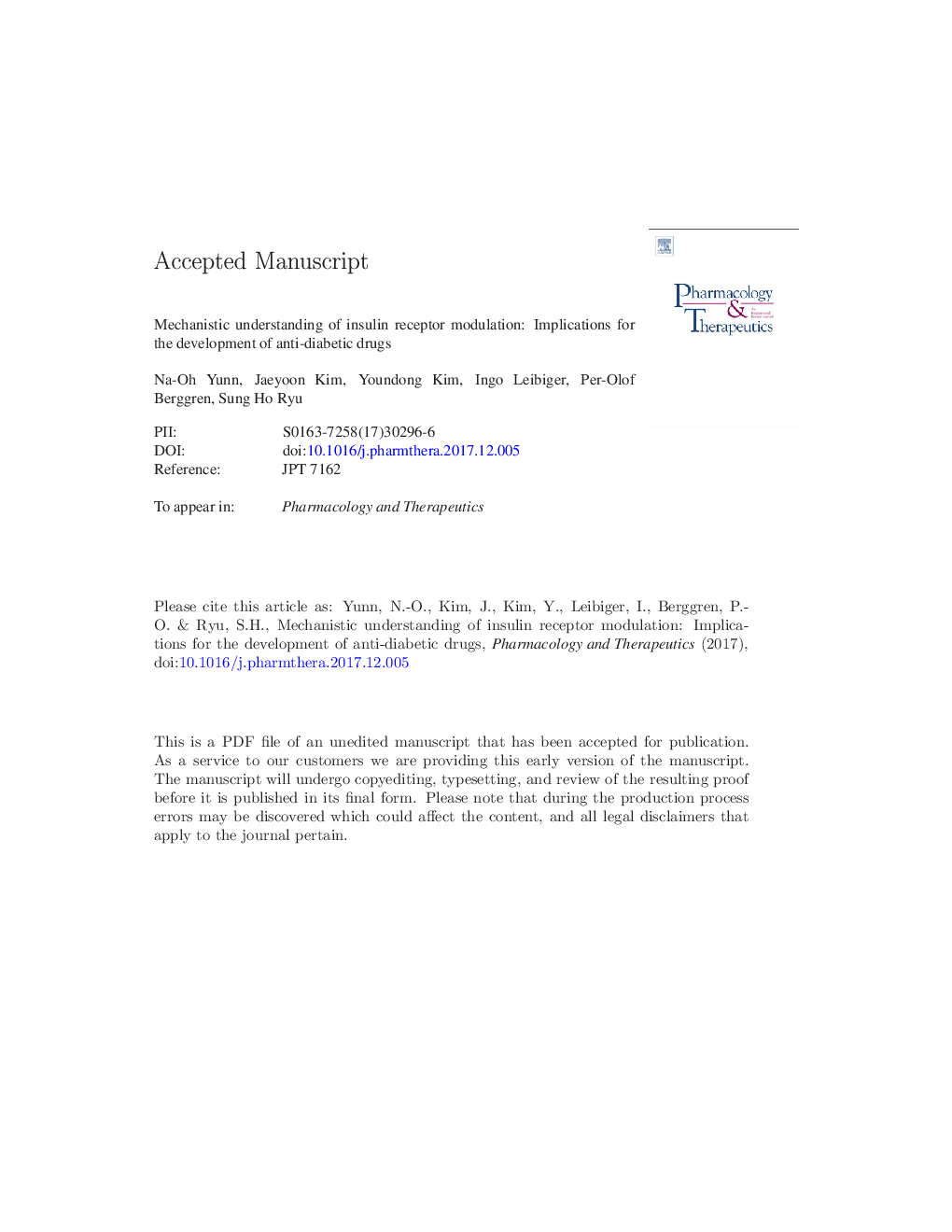| کد مقاله | کد نشریه | سال انتشار | مقاله انگلیسی | نسخه تمام متن |
|---|---|---|---|---|
| 8536847 | 1560920 | 2018 | 40 صفحه PDF | دانلود رایگان |
عنوان انگلیسی مقاله ISI
Mechanistic understanding of insulin receptor modulation: Implications for the development of anti-diabetic drugs
ترجمه فارسی عنوان
درک مکانیکی از مدولاسیون گیرنده انسولین: اثرات جانبی برای توسعه داروهای ضد دیابت
دانلود مقاله + سفارش ترجمه
دانلود مقاله ISI انگلیسی
رایگان برای ایرانیان
ترجمه چکیده
گیرنده انسولین تنظیم کننده مهم فرآیندهای متابولیک در بدن و به ویژه هوموتاز گلوکز، از جمله جذب گلوکز به بافت های محیطی است. بنابراین، تزریق انسولین یک درمان مؤثر برای دیابت است که با افزایش مزمن گلوکز خون مشخص می شود. با این حال، انسولین نه تنها یک تنظیم کننده متابولیک است، بلکه همچنین به عنوان یک هورمون رشد عمل می کند. بر این اساس، مطالعات در مورد درازمدت تزریق انسولین و هیپرانسولینمی در ارتباط با دیابت نوع 2 باعث نگرانی در مورد احتمال افزایش احتمال ابتلا به سرطان و آترواسکلروز در اثر تحریک بیش از حد از تکثیر سلولی شده است. جالب توجه است، برخی از لیگاندهای گیرنده انسولین که بر اساس یک پپتید، یک آنتیبادی و یک آپتامر تولید شده اند، به طور انتخابی دارای اثرات متابولیکی هستند که از طریق گیرنده انسولین به وجود می آیند، اما باعث افزایش پرولیفراسیون سلولی نمی شوند. گرچه این لیگاندها به عنوان داروهای ضد دیابتی برای مراقبتهای پیشرفته دیابت به عنوان پدیده ای شناخته شده اند، مکانیسم که به طور خاص آنها را فعال می کند، گیرنده انسولین هنوز مشخص نیست. به تازگی، مطالعه ساختار گیرنده انسولین به میزان قابل توجهی پیشرفت کرده است و درک مکانیسم بیشتری در مورد فعال شدن گیرنده انسولین ارائه کرده است. بر اساس این پیشرفت، ما یک مدل مکانیستی از این ویژگی را پیشنهاد می دهیم و در مورد پتانسیل توسعه داروهای جدید ضد دیابتی که اثرات نامطلوب ناشی از فعالیت بیش از حد میتوز را ندارند بحث می شود.
موضوعات مرتبط
علوم پزشکی و سلامت
داروسازی، سم شناسی و علوم دارویی
داروشناسی
چکیده انگلیسی
The insulin receptor is an important regulator of metabolic processes in the body, and in particular of glucose homeostasis, including glucose uptake into peripheral tissues. Thus, insulin administration is an effective treatment for diabetes, which is characterized by chronic elevation of blood glucose. However, insulin is not only a metabolic regulator, but also functions as a growth hormone. Accordingly, studies of long-term insulin administration and of the hyperinsulinemia associated with type 2 diabetes have raised concerns about possible increases in the risks of cancer and atherosclerosis, due to excessive stimulation of cell proliferation. Interestingly, some insulin receptor ligands that have been developed based on a peptide, an antibody, and an aptamer selectively have metabolic effects exerted through the insulin receptor but do not cause significant cellular proliferation. Although these ligands therefore have potential as anti-diabetic drugs for advanced diabetes care, the mechanism whereby they specifically activate the insulin receptor is still unclear. Recently, studies of the structure of the insulin receptor have progressed considerably, and have provided further mechanistic understanding of insulin receptor activation. Based on this progress, we propose a mechanistic model of this specificity and discuss the potential for the development of novel anti-diabetic drugs that would not have the adverse effects caused by excessive mitogenic action.
ناشر
Database: Elsevier - ScienceDirect (ساینس دایرکت)
Journal: Pharmacology & Therapeutics - Volume 185, May 2018, Pages 86-98
Journal: Pharmacology & Therapeutics - Volume 185, May 2018, Pages 86-98
نویسندگان
Na-Oh Yunn, Jaeyoon Kim, Youndong Kim, Ingo Leibiger, Per-Olof Berggren, Sung Ho Ryu,
